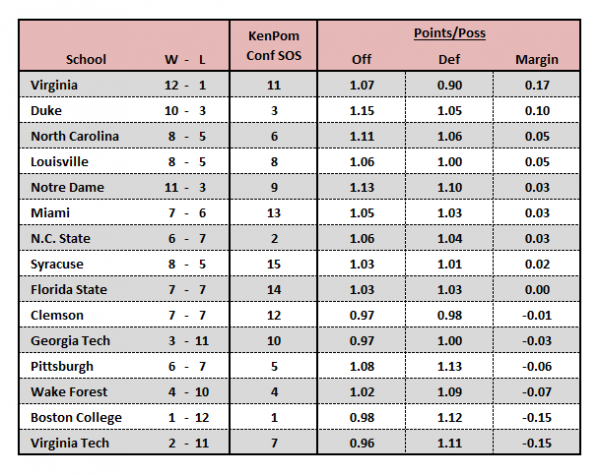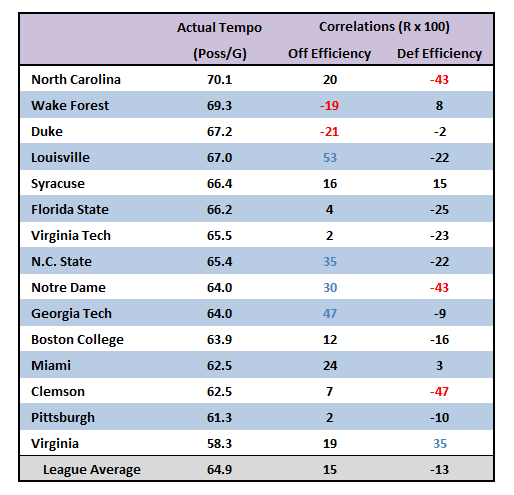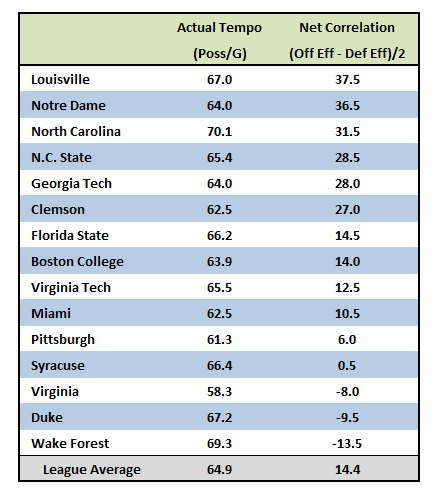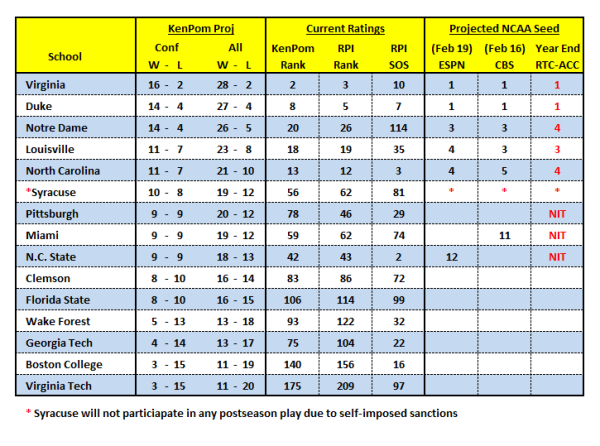Inside the ACC Numbers: Volume V
Posted by Brad Jenkins (@bradjenk) on February 20th, 2015This is the latest edition of a weekly look at the current ACC standings and corresponding team performances, focusing on the teams that are playing better or worse than their records might indicate. We will also delve into some advanced metrics to find a few interesting team or player stats and trends. Finally, we will forecast how the final standings may look, and what that means for ACC schools’ postseason aspirations.
Note: All numbers are current for games played through Wednesday, February 18.
Current Standings
With three weekends of conference play remaining, things are now mostly as they should be in the standings with respect to matching points per possession margin (PPM) with actual wins and losses. Virginia maintains a clear lead in both the standings and in PPM, and Duke can lay claim to being the second best team, with a clear PPM edge over Notre Dame. Last week we showed how the Irish have achieved their impressive 11-3 record by performing so well in close games, noting that Georgia Tech is the exact opposite reflection of Notre Dame in both PPM and actual record. It’s seems fitting then that those two teams have squared off twice already, and each game ended with a close Irish victory. Another interesting situation involves two teams fighting for NCAA Tournament consideration, N.C. State and Pittsburgh. Each school picked up a nice win over a ranked opponent last weekend but both the Wolfpack and the Panthers remain a game below .500 in the standings. That’s where the similarities end, though, as N.C. State has been the far better team in possession-based performance, with Pittsburgh’s defense surprisingly ranked as the league’s worst.
There are once again no match-ups involving two of the ACC’s five elite teams on the schedule this weekend. In the only game involving two teams with winning conference records, Louisville travels to Miami (Saturday @ 2:00 PM ET – ESPN) in a crucial game for the Hurricanes and their NCAA Tourney hopes. There are also a couple of games that feature an ACC heavyweight hosting a school that’s looking to get over the .500 mark, as Clemson visits Duke (Saturday @ 4:00 PM ET – ESPN), and Virginia entertains Florida State (Sunday @ 6:30 PM ET – ESPNU). In another important contest, Pittsburgh needs to win at Syracuse (Saturday @ Noon ET – ACCN) to keep any hope alive of making the Dance.
Advanced Stat of the Week: The Impact of Tempo
This week we take a look at how tempo relates to a team’s offense, defense and overall performance. We hear experts say things like, “you need to speed Virginia up” and “you better find a way to slow the pace down against North Carolina.” Are those strategic notions actually supported by the facts? When a coach talks about directing the game’s tempo, how can we determine what that pace should really be? Fortunately, Ken Pomeroy has data available that can help us answer this question. In a feature he calls Game Plan (explained here), he measures different correlations between a team’s offensive and defensive efficiencies. In other words, what statistical impact a factor has on a team’s performance — the higher the number, the greater impact. One of the measurables in the data set is tempo, which is defined as the number of possessions per game. Below we show the correlations between tempo and each ACC team’s offense and defense for all games.
A positive number in the offensive efficiency column means that the more possessions there are in a game, the better that team’s offense performs. Likewise, having a negative number in the defensive efficiency column shows that a faster pace is beneficial to that team’s defense. Across the league it appears that faster play equates to more efficient scoring, but that could be a bit misleading. These numbers are for all games played, so they include a bunch of non-conference mismatches from the first half of the season. Overall team tempo and efficiency both tend to drop as teams get into league play. Unfortunately we don’t have this data available for ACC play only, but even if we did, the accuracy of the correlation could be impacted by a very small sample size. That disclaimer aside, it appears that some squads see a real boost in their offensive execution when the pace quickens — namely Louisville and Georgia Tech. Also, faster-paced games are better for the defenses of North Carolina and Notre Dame. Now let’s try to relate pace of play to overall performance.
Above we list the teams in order of impact based on tempo. To do this we simply halved the difference in tempo correlations to offense and defense, so that it projects the relationship between pace of play and overall team performance. Let’s go back to our original questions and see if we now have some answers. In the case of Virginia, it appears that if you can somehow speed up the Cavs (good luck with that) you will have a better chance of hanging with the ACC’s top team. And it also looks like the book on North Carolina is accurate – the faster the pace, the more Roy Williams likes it. It’s also no shock to see Louisville as the biggest beneficiary of up-tempo play, with Rick Pitino’s aggressive brand of basketball working to his benefit at both ends of the floor. There are a few surprises on the list as well. Who would have thought that Georgia Tech and Clemson might actually perform better as the pace increases? And that Duke and Wake Forest, two of the highest tempo squads in the league, would be wiser to lower their possessions a bit. Finally, note that Syracuse does not seem to be affected at all by pace of play, perhaps because the zone it employs tends to keep the pace pretty consistent from game to game.
Future Forecast
The above table shows a predicted order of finish with final regular season records based on Ken Pomeroy’s current win probabilities. We have also included a few comparative rankings that are mentioned frequently when evaluating NCAA Tournament potential as well as projections from two bracketology experts, ESPN‘s Joe Lunardi and CBS Sports‘ Jerry Palm. Note that while their projections are made as if the field was named tomorrow, we make ours based on final projected records. We still have the ACC with only five teams heading to the Dance. Even though Miami and Pittsburgh have better projected records than N.C. State, we still consider the Wolfpack a more attractive at-large NCAA candidate than the others based on that extremely high strength of schedule rating. That same metric is what we think will cause Notre Dame to drop to a seed that’s lower than you would expect for a team with its record.















































Great post. It’s really surprising to see Duke’s negative tempo correlation number – why do you think that might be?
Thanks Tyer. Honestly, I think the Duke number is probably skewed by some extreme performances. Clearly their two worst performances of the year were the back-to-back losses to N.C. State and Miami, which ended up as high possession games, because Duke was forcing pace to try and catch up. Conversely, two of their best games were the wins over Wisconsin and Virginia which were going to be low possession games anyway, but Duke played well in both.